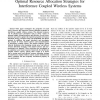Free Online Productivity Tools
i2Speak
i2Symbol
i2OCR
iTex2Img
iWeb2Print
iWeb2Shot
i2Type
iPdf2Split
iPdf2Merge
i2Bopomofo
i2Arabic
i2Style
i2Image
i2PDF
iLatex2Rtf
Sci2ools
INFOCOM
2010
IEEE
2010
IEEE
Characterization of Non-Manipulable and Pareto Optimal Resource Allocation Strategies for Interference Coupled Wireless Systems
This paper investigates the properties of social choice functions that represent resource allocation strategies in interference coupled wireless systems. The allocated resources can be physical layer parameters such as power vectors or antenna weights. Strategy proofness and efficiency of social choice functions are used to capture the respective properties of resource allocation strategy outcomes being non-manipulable and Pareto optimal. In addition, this paper introduces and investigates the concepts of (strict) intuitive fairness and non-participation in interference coupled systems. The analysis indicates certain inherent limitations when designing strategy proof and efficient resource allocation strategies, if the intuitive fairness and non
Communications | INFOCOM 2010 | Resource Allocation | Resource Allocation Strategy | Social Choice Function |
| Added | 13 Feb 2011 |
| Updated | 13 Feb 2011 |
| Type | Journal |
| Year | 2010 |
| Where | INFOCOM |
| Authors | Holger Boche, Siddharth Naik, Tansu Alpcan |
Comments (0)

